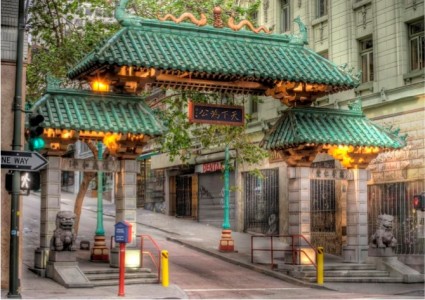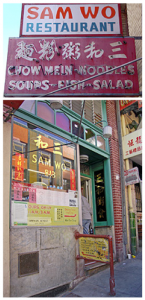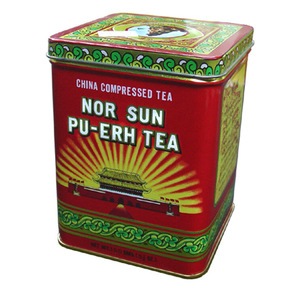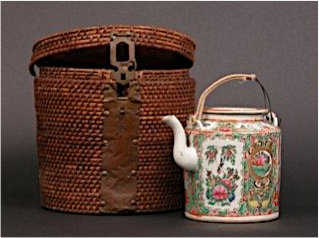Memories of Pu’er Tea
 Pu’er cha 普洱茶 is a hot Chinese drink familiar to almost anyone eating in an old Hong Kong style restaurant and drinking its tea. In such a place and in times long past, Pu’er was the only tea of consequence. This was especially true in San Francisco’s Chinatown, which in the early 1950s was packed, cheek by jowl, with dives like the Buddha Lounge and green grocers and a myriad restaurants, big and small.
Pu’er cha 普洱茶 is a hot Chinese drink familiar to almost anyone eating in an old Hong Kong style restaurant and drinking its tea. In such a place and in times long past, Pu’er was the only tea of consequence. This was especially true in San Francisco’s Chinatown, which in the early 1950s was packed, cheek by jowl, with dives like the Buddha Lounge and green grocers and a myriad restaurants, big and small.
At the high end of the culinary scale was Kan’s, a posh establishment with a gold and scarlet interior, plush drapes and upholstered chairs, where suave waiters paraded in slicked back hair, starched white shirts, bowties, and black vests, serving exotic bird’s nest soup and sauced sea cucumbers. Kan’s menu raised the bar, attracting well heeled patrons, politicians, and movie stars.
A humbler affair but equally famous, Sam Wo occupied a unique spot on the eat-o-meter. Housed in a narrow space squeezed tightly between two buildings, the sparsely furnished upper floors were reached only by brushing past fiery stoves and wiry cooks wielding cleavers and woks. Sizzling and splattering, the tiny kitchen dished out congee 粥, fen 粉, and noodles 麵, the “three harmonies” for which Sam Wo 三和 was named.
 Sam Wo’s questionable charm was perversely enhanced by rickety stools and wobbly tables and a notoriously insolent waiter. Choosing the unlikely name Edsel Ford Fong, he roundly entertained everyone by gruffly abusing each customer while expertly tossing about clattering plates of savory chowmein, bowls of wonton, and mounds of sliced raw fish with slivers of red ginger over crisped noodles.
Sam Wo’s questionable charm was perversely enhanced by rickety stools and wobbly tables and a notoriously insolent waiter. Choosing the unlikely name Edsel Ford Fong, he roundly entertained everyone by gruffly abusing each customer while expertly tossing about clattering plates of savory chowmein, bowls of wonton, and mounds of sliced raw fish with slivers of red ginger over crisped noodles.
Regardless of the place chosen – high or low – Kan’s or Edsel’s – once seated, all were welcomed by a steaming pot of tea served out in a small cup as a matter of custom and courtesy, and because a proper meal always began with Pu’er.
On the weekends, Pu’er tea was essential when observing yumcha 飲茶, literally to “drink tea,” an occasion when whole families met for brunch over rounds of dimsum 點心, the nearly endless array of savory fare that was so expensive to create that only restaurants offered it, so dizzyingly rich that it was served just in small portions, and so utterly satisfying that it “dotted the heart.” As each delicious morsel was consumed, empty pots were replenished and cups refilled, the Pu’er sipped slowly to cleanse the palate in anticipation of the lush flavors of the next tempting dish. As plates piled up and bits of gossip flew about the table, drinking Pu’er tea aided digestion, stemmed the tide of triglycerides, and cleared foggy heads. And in those empty moments of soft silence, a sip of Pu’er and a pensive nod helped fill the conversation.
On the way home, a stop at the Chinese grocery store acquired the week’s household quota of loose Pu’er packed in a small square tin. Back at the house, opening the box revealed an inner lid and inside that, a cellophane bag chock full of dark brown leaves mixed with twigs and stems. When opened, the tea filled the nose with the scent of dry wood and dirt.
A heaping tablespoon fed a perpetual Pu’er that filled the old porcelain pot, kept warm in a wicker cozy, the tea shared by young and old throughout the day quenching thirst, refreshing the mind, restoring vigor, and lifting the mood.
The tea was drunk all year round, but in summer or hot weather dried chrysanthemum blossoms were added for their cooling effect. To treat a cold or for just a treat, children drank Pu’er poured steaming hot over a piece of preserved fruit such as longan, jujube, or lemon peel that flavored the tea. When the tea was finished, the juicy bit was a tasty prize sucked and swallowed. On Chinese holidays, crystallized ginger, sugared coconut and lotus root were traditional favorites for sweetening life and cups of Pu’er.
As with all good things – polished rice, sesame oil, fragrant soy, and fine vinegar – Pu’er tea was indispensable, and its very presence the certain sign of a prospering and stable home.


